Pennsylvania Station (New York City)
Pennsylvania Station, also known as New York Penn Station or Penn Station, is the main intercity railroad station in New York City and the busiest in the Western Hemisphere, serving more than 600,000 passengers per weekday as of 2019.[5][6][lower-alpha 1] Penn Station is in Midtown Manhattan, close to Herald Square, the Empire State Building, Koreatown, and Macy's Herald Square. Entirely underground, the station is located in Midtown South beneath Madison Square Garden, between Seventh and Eighth Avenues, and between 31st and 33rd Streets, with additional exits to nearby streets.
Penn Station has 21 tracks fed by seven tunnels (the two North River Tunnels, the four East River Tunnels, and the single Empire Connection tunnel). It is at the center of the Northeast Corridor, a passenger rail line that connects New York City with Boston, Philadelphia, Washington, D.C., and intermediate points. Intercity trains are operated by Amtrak, which owns the station, while commuter rail services are operated by the Long Island Rail Road (LIRR) and NJ Transit (NJT). Connections are available within the complex to the New York City Subway, and buses. An underground passageway formerly provided an indoor connection with the 34th Street–Herald Square subway station and 33rd Street PATH station.[7]
Penn Station is named for the Pennsylvania Railroad (PRR), its builder and original tenant, and shares its name with several stations in other cities. The current facility is the remodeled underground remnant of the original Pennsylvania Station, a more ornate station building designed by McKim, Mead, and White and considered a masterpiece of the Beaux-Arts style. Completed in 1910, it enabled direct rail access to New York City from the south for the first time. Its head house was torn down in 1963, galvanizing the modern historic preservation movement.[8] The rest of the station was rebuilt in the following six years, while retaining most of the rail infrastructure from the original station.
Future plans for Penn Station include adding railway platforms at the station's south end to accommodate two proposed Gateway Program tunnels. Plans also call for adding entrances and concourses to the adjacent James A. Farley Building. The Farley Post Office was built as a companion to the 1910 station. Moynihan Train Hall, part of the Empire Station Complex, will add new concourses for the LIRR and Amtrak within the Farley Post Office building and is being built in phases.[9]
History
Planning and construction (1901–1910)
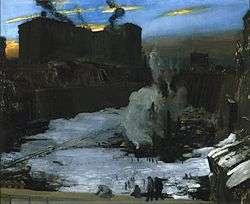
Until the early 20th century, the PRR's rail network terminated on the western side of the Hudson River (once known locally as the North River) at Exchange Place in Jersey City, New Jersey. Manhattan-bound passengers boarded ferries to cross the Hudson River for the final stretch of their journey.[10] The rival New York Central Railroad's line ran down Manhattan from the north under Park Avenue and terminated at Grand Central Depot (later Grand Central Station, now Terminal) at 42nd Street.[11] Many proposals for a cross-Hudson connection were advanced in the late 19th century, but financial panics in the 1870s and 1890s scared off potential investors. In any event, none of the proposals advanced during this time were considered feasible.[12]
An early proposal for a bridge was considered but rejected.[13][14] The alternative was to tunnel under the river, but this was infeasible for steam locomotive use.[15] The development of the electric locomotive at the turn of the 20th century made a tunnel feasible. In 1901, PRR president Alexander Cassatt announced the railroad's plan to enter New York City by tunneling under the Hudson and building a grand station on the West Side of Manhattan south of 34th Street.[16] The station would sit in Manhattan's Tenderloin district, a historical red-light district known for its corruption and prostitution.[17]
Beginning in June 1903, the two single-track North River Tunnels were bored from the west under the Hudson River.[18] A second set of four single-track tunnels, the East River Tunnels, were bored from the east under the East River, linking the new station to Queens, the PRR-owned Long Island Rail Road, and Sunnyside Yard in Queens, where trains would be maintained and assembled.[19] Construction was completed on the Hudson River tunnels on October 9, 1906,[20] and on the East River tunnels on March 18, 1908.[21]
Original structure
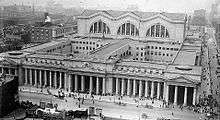

A small portion of Penn Station was opened on September 8, 1910, in conjunction with the opening of the East River Tunnels. As a result, LIRR riders gained direct railroad service to Manhattan.[22] On November 27, 1910, Penn Station was fully opened to the public.[23] With the station's full opening, the PRR became the only railroad to enter New York City from the south.[24]
During half a century of operation by the Pennsylvania Railroad (1910–1963), scores of intercity passenger trains arrived and departed daily to Chicago and St. Louis on “Pennsy” rails and beyond on connecting railroads to Miami and the west. Along with Long Island Rail Road trains, Penn Station saw trains of the New Haven and the Lehigh Valley Railroads. A side effect of the tunneling project was to open the city up to the suburbs, and within 10 years of opening, two-thirds of the daily passengers coming through Penn Station were commuters.[17] The station put the Pennsylvania Railroad at comparative advantage to its competitors offering direct service from Manhattan to the west and south. Other railroads began their routes at terminals in Weehawken, Hoboken, Pavonia and Communipaw which required passengers from New York City to take the interstate Hudson Tubes (now PATH) or ferries across the Hudson River before boarding their trains. By 1945, at its peak, more than 100 million passengers a year traveled through Penn Station.[17]
By the late 1950s, intercity rail passenger volumes had declined dramatically with the coming of the Jet Age and the Interstate Highway System. Even before then, the station's exterior had become somewhat grimy. Due to its vast scale, the station was very expensive to maintain.[25][26] A renovation around this time covered some of the grand columns with plastic and blocked off the spacious central hallway with a new ticket office. The Pennsylvania Railroad optioned the air rights of Penn Station in the 1950s. The option called for the demolition of the head house and train shed, to be replaced by an office complex and a new sports complex, while the tracks of the station would remain untouched.[27] Plans for the new Penn Plaza and Madison Square Garden were announced in 1962. In exchange for the air rights to Penn Station, the PRR would receive a smaller underground station at no cost and a 25 percent stake in the new Madison Square Garden Complex. Modern architects rushed to save the ornate building, but to no avail.[28] Demolition of the above-ground head house began in October 1963.[29] A giant steel deck was placed over the tracks and platforms to allow rail service to continue with only minor disruptions; photographs of the day showed passengers waiting for trains even as the head house was demolished around them.[25] This was possible because most of the rail infrastructure (including the waiting room, concourses, and boarding platforms) was below street level.[30]
The demolition of the Penn Station head house was controversial and caused outrage internationally.[31][32] "One entered the city like a god. One scuttles in now like a rat,” the architectural historian Vincent Scully famously wrote of the original station.[33] The controversy over the demolition of such a well-known landmark, and its deplored replacement,[34] is often cited as a catalyst for the architectural preservation movement in the United States.[8] New laws were passed to restrict such demolition. Within the decade, Grand Central Terminal was protected under the city's new landmarks preservation act, a protection upheld by the courts in 1978 after a challenge by Grand Central's owner, Penn Central.[35]
Current structure (1968–present)
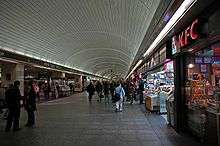
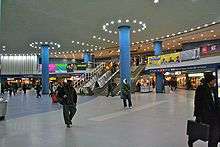
The current Penn Station is completely underground, and sits below Madison Square Garden, 33rd Street, and Two Penn Plaza. The station has three levels: concourses on the upper two levels and train platforms on the lowest. The two levels of concourses, while original to the 1910 station, were extensively renovated during the construction of Madison Square Garden, and expanded in subsequent decades. The tracks and platforms are also largely original, except for some work connecting the station to the West Side Rail Yard and the Amtrak Empire Corridor serving Albany and Buffalo, New York.[36][37]
In 1991, the opening of the Empire Connection allowed Amtrak to consolidate all of its New York City trains at Penn Station. Previously, all trains traveling along the Empire Corridor originated and terminated at nearby Grand Central Terminal–a legacy of most of those routes previously being part of the New York Central Railroad. Previously, passengers transferring between Northeast Corridor and Empire Corridor routes had to make their own way between the two stations. The two stations have never been connected, even after they both came under ownership of Penn Central in the 1960s and after Amtrak took over all intercity service in 1971. The move also spared Amtrak the expense of maintaining two New York stations, as well as having to pay the MTA over $600,000 per year to use Grand Central's trackage.[38][39]
In the 1990s, the current Pennsylvania Station was renovated by Amtrak, the Metropolitan Transportation Authority, and New Jersey Transit, to improve the appearance of the waiting and concession areas, sharpen the station information systems (audio and visual) and remove much of the grime. Recalling the erstwhile grandeur of the bygone Penn Station, an old four-sided clock from the original depot was installed at the 34th Street Long Island Rail Road entrance. The walkway from that entrance's escalator also has a mural depicting elements of the old Penn Station's architecture.
There is an abandoned underground passageway from Penn Station to the nearby 34th Street–Herald Square subway station and 33rd Street PATH station, which was known as "Gimbels Passageway." After decades of safety and sanitation concerns, an epidemic of sexual assaults finally led to its closure in the 1980s.[7]
After the September 11 attacks in 2001, security was increased and passenger flow through the Penn Station complex was curtailed. In 2002, work began on a $100 million improvement to add security features inside Penn Station, such as lighting, security cameras, and barricades.[40] The taxiway under Madison Square Garden, which ran from 31st Street north to 33rd Street halfway between 7th and 8th Avenues, was closed off with concrete Jersey barriers. A covered walkway from the taxiway was constructed to guide arriving passengers to a new taxi-stand on 31st Street. In addition, the direct connection escalators from Penn Station to the lobby of Madison Square Garden were closed and later removed.
Despite the improvements, Penn Station continues to be criticized as a low-ceilinged "catacomb" lacking charm, especially when compared to the much larger and more ornate Grand Central Terminal.[31] The New York Times, in a November 2007 editorial supporting development of an enlarged railroad terminal, said that "Amtrak's beleaguered customers...now scurry through underground rooms bereft of light or character."[41] Times transit reporter Michael M. Grynbaum later called Penn Station "the ugly stepchild of the city’s two great rail terminals."[26] Times architecture critic Michael Kimmelman wrote that while downsizing Penn Station and moving it entirely underground may have made a modicum of sense at the time, in hindsight it was a sign that New York was "disdainful of its gloried architectural past." Kimmelman also argued that the remodeling resulted in a station that was no longer commensurate with its status as the main rail gateway to New York.[25] Earlier, Christopher Gray of the Times wrote in 2001 that "there would be no shortage of bodies to sit in front of the bulldozers" to save the older, larger Penn Station.[28]
Services
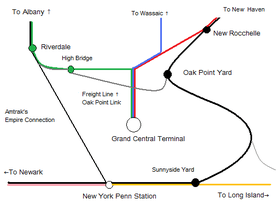
The station is served by 1,300 arrivals and departures per day, twice the number during the 1970s.[42] There are more than 600,000 commuter rail and Amtrak passengers who use the station on an average weekday,[43][44] or up to 1,000 every ninety seconds.[26][45]:498, 891 It is the busiest passenger transportation facility in the United States[46] and in North America.[45]:890–891
Intercity rail
Amtrak
Amtrak owns the station and uses it for the following services:
- Acela Express to Boston (northern terminus) and Washington D.C. (southern terminus)
- Adirondack to Montréal
- Cardinal to Chicago
- Carolinian to Charlotte
- Crescent to New Orleans
- Empire Service to Albany and Niagara Falls, NY
- Ethan Allen Express to Rutland
- Keystone Service to Harrisburg
- Lake Shore Limited to Chicago
- Maple Leaf to Toronto
- Pennsylvanian to Pittsburgh
- Northeast Regional to Boston or Springfield (northern termini) and Roanoke, Newport News, or Norfolk (southern termini)
- Palmetto to Savannah
- Silver Meteor to Miami
- Silver Star to Miami
- Vermonter to Washington D.C. (southern terminus) and St. Albans (northern terminus)
All except the Acela Express, Northeast Regional and Vermonter originate and terminate at Penn Station.
Despite its status as Amtrak's busiest station, Amtrak's Superliner railcars cannot use Penn Station due to inadequate clearances in the North River and East River tunnels.
Amtrak normally uses tracks 1–12 alongside New Jersey Transit, and shares tracks 13–16 with the LIRR and NJ Transit.
Commuter rail
Long Island Rail Road
The following Long Island Rail Road (LIRR) services originate and terminate at Penn Station:
- Babylon Branch to Babylon with connecting service to Montauk
- Belmont Park Branch seasonal service to Belmont Park
- City Terminal Zone with connecting service at Jamaica station
- Far Rockaway Branch to Far Rockaway, Queens in New York City
- Hempstead Branch to Hempstead
- Long Beach Branch to Long Beach
- Montauk Branch to Babylon and Montauk
- Oyster Bay Branch to Oyster Bay
- Port Jefferson Branch to Huntington and Port Jefferson
- Port Washington Branch to Great Neck and Port Washington
- Ronkonkoma Branch to Ronkonkoma and Long Island MacArthur Airport with connecting service to Greenport
- West Hempstead Branch to Hempstead
All branches connect at Jamaica station except the Port Washington Branch.
Normally, the LIRR uses tracks 17–21 exclusively and shares tracks 13–16 with Amtrak and NJT. The LIRR uses tracks 11–12 on rare occasions.
New Jersey Transit
The following NJ Transit Rail Operations (NJT) branches originate and terminate at Penn Station:
- Montclair-Boonton Line to Montclair, and points west to Hackettstown
- Morris and Essex Lines to Summit and Dover and points west to Hackettstown or the Gladstone branch.
- Northeast Corridor Line to Trenton
- North Jersey Coast Line to Long Branch, with connecting service to Bay Head
- Raritan Valley Line to Raritan and High Bridge (Service currently suspended past Newark Penn Station to New York until further notice)
NJT normally shares tracks 1–12 with Amtrak and tracks 13–16 with Amtrak and LIRR. The NJT uses track 17 on rare occasions.
Rapid transit
New York City Subway
Connections are available to the following New York City Subway stations:[47]
- From Penn Station:
- A, C, and E trains at 34th Street–Penn Station station, under Eighth Avenue
- 1, 2, and 3 trains at 34th Street–Penn Station station, under Seventh Avenue
- From Herald Square, one block east at Sixth Avenue:
PATH
Connections are also available to the PATH system at 33rd Street station, under Sixth Avenue on Herald Square. The JSQ-33 and HOB-33 services terminate at 33rd Street on weekdays, and are combined into the JSQ-33 (via HOB) service on late nights, weekends and holidays.
Bus and coach
NYC Airporter provides bus transportation to and from John F. Kennedy International Airport and LaGuardia Airport, and is authorized by the Port Authority of New York and New Jersey and the New York City Department of Transportation.
New York City Bus
The following MTA Regional Bus Operations buses stop near Penn Station:[48]
- M7 (Lenox, Columbus, Amsterdam, Sixth and Seventh Avenues): southbound to Greenwich Village, via Seventh Avenue; or northbound to Harlem via Sixth, Amsterdam, and Lenox Avenues
- M20 (Seventh and Eighth Avenues/Varick and Hudson Streets): northbound to Lincoln Center via Eighth Avenue; or southbound to South Ferry via Seventh Avenue
- M34 Select Bus Service (34th Street Crosstown): westbound to Javits Center; or eastbound to FDR Drive
- M34A Select Bus Service (34th Street Crosstown): westbound to Port Authority Bus Terminal; or eastbound to Waterside Plaza and Kips Bay
- Q32 (Fifth and Madison Avenues): northbound only, to Jackson Heights, Queens
Intercity coaches
Intercity bus service to and from Penn Station is provided by BoltBus, Vamoose Bus, Tripper Bus, and Go Buses. BoltBus operates from two stops at Penn Station. Penn Station Bus Stop #1 has service to Baltimore; Greenbelt, Maryland; and two stops in Washington, D.C. Penn Station Bus Stop #2 has service to Boston; Cherry Hill, New Jersey; and Philadelphia. Vamoose Bus runs buses from a stop near Penn Station to Bethesda, Maryland; Arlington, Virginia; and Lorton, Virginia.[49] Tripper Bus runs buses from a stop near Penn Station to Bethesda, Maryland and Arlington, Virginia.[50] Go Buses runs buses from a stop near Penn Station to Newton, Massachusetts and Cambridge, Massachusetts.
Airline ticketing
Penn Station includes a United Airlines ticketing office, located at the ticket lobby.[51] This was previously a Continental Airlines ticketing office.[52]
Proposed Metro-North service
The Metropolitan Transportation Authority has proposed to bring Metro-North Railroad commuter trains to Penn Station as part of its Penn Station Access project. The first phase of the project would bring New Haven Line trains to Penn Station via Amtrak's Hell Gate Bridge and the East River Tunnels. The second phase would bring Hudson Line service to the station via the Empire Connection.[53]
Station layout
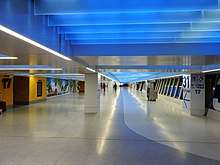
Penn Station does not have a unified design or floor plan but rather is divided into separate Amtrak, Long Island Rail Road and New Jersey Transit concourses with each concourse maintained and styled differently by its respective operator.[54] Amtrak and NJ Transit concourses are located on the first level below the street-level while the Long Island Rail Road concourse is two levels below street-level. The NJ Transit concourse near Seventh Avenue is the newest and opened in 2002 out of existing retail and Amtrak office space.[55][56] A new entrance to this concourse from West 31st Street opened in September 2009.[57] Previously, NJ Transit shared space with the Amtrak concourse. The main LIRR concourse runs below West 33rd Street between Seventh and Eighth Avenues. Significant renovations were made to this concourse over a three-year period ending in 1994, including the addition of a new entry pavilion on 34th Street.[58] The LIRR's West End Concourse, west of Eighth Avenue, opened in 1986.[59] The station is so complex that in December 2017, Amtrak and Zyter released a mobile app called FindYourWay to help commuters navigate around Penn Station, though Zyter also plans to roll out the app at other large Amtrak stations.[60]
As further evidence of its complexity, the station's three providers use different official addresses for the station.
- Amtrak: 8th Avenue and West 31st Street
- LIRR: 34th Street at 7th and 8th Avenues
- NJ Transit: 390 7th Avenue
| Station layout | ||
|---|---|---|
| Above ground | Madison Square Garden/Two Penn Plaza[61] | |
| G | Street Level | Exit/Entrance |
| UC | Amtrak Concourse | Amtrak tickets, transfer to 34th Street–Penn Station (IND Eighth Avenue Line) station; exit to 33rd Street, connection to Exit and Connecting concourses[61] |
| NJT Concourse | NJT tickets, exit to 31st Street, connect to LIRR and Hilton concourses[61] | |
| LC | West End Concourse | Amtrak/LIRR tickets, transfer to 34th Street–Penn Station (IND Eighth Avenue Line) station; exit to 33rd Street, connection to Exit and Connecting concourses[61] |
| Exit Concourse | Exit to 31st Street, connection to Hilton, West End, and Connecting concourses[61] | |
| Hilton Corridor | Exit to Seventh Avenue, connection to Exit, LIRR, Central, and NJT concourses[61] | |
| Central Concourse | Tickets, connection to Connecting and Hilton concourses[61] | |
| Connecting Concourse | Transfer to 34th Street–Penn Station (IRT Broadway–Seventh Avenue Line) station, connection to West End, LIRR, Central, and Exit concourses, to One Penn Plaza and 34th Street at north end[61] | |
| LIRR Concourse | LIRR tickets, connection to NJT and Hilton concourses[61] | |
| P Platform level |
Track 21 | LIRR toward Long Island (Woodside or Jamaica) → |
| Island platform (Platform K) | ||
| Track 20 | LIRR toward Long Island (Woodside or Jamaica) → | |
| Track 19 | LIRR toward Long Island (Woodside or Jamaica) → | |
| Island platform (Platform J) | ||
| Track 18 | LIRR toward Long Island (Woodside or Jamaica) → | |
| Island platform (Platform I); Track 17 only | ||
| Track 17 | LIRR toward Long Island (Woodside or Jamaica) → | |
| Track 16 | ← Amtrak/New Jersey Transit/LIRR → | |
| Island platform (Platform H) | ||
| Track 15 | ← Amtrak/New Jersey Transit/LIRR → | |
| Track 14 | ← Amtrak/New Jersey Transit/LIRR → | |
| Island platform (Platform G) | ||
| Track 13 | ← Amtrak/New Jersey Transit/LIRR → | |
| Track 12 | ← Amtrak/New Jersey Transit/LIRR → | |
| Island platform (Platform F) | ||
| Track 11 | ← Amtrak/New Jersey Transit → | |
| Track 10 | ← Amtrak/New Jersey Transit → | |
| Island platform (Platform E) | ||
| Track 9 | ← Amtrak/New Jersey Transit → | |
| Track 8 | ← Amtrak/New Jersey Transit → | |
| Island platform (Platform D) | ||
| Track 7 | ← Amtrak/New Jersey Transit → | |
| Track 6 | ← Amtrak/New Jersey Transit → | |
| Island platform (Platform C) | ||
| Track 5 | ← Amtrak/New Jersey Transit | |
| Track 4 | ← New Jersey Transit toward New Jersey (Secaucus Junction, Newark Broad Street, or Newark Penn) | |
| Island platform (Platform B) | ||
| Track 3 | ← New Jersey Transit toward New Jersey (Secaucus Junction, Newark Broad Street, or Newark Penn) | |
| Track 2 | ← New Jersey Transit toward New Jersey (Secaucus Junction, Newark Broad Street, or Newark Penn) | |
| Island platform (Platform A) | ||
| Track 1 | ← New Jersey Transit toward New Jersey (Secaucus Junction, Newark Broad Street, or Newark Penn) | |
Tracks and surrounding infrastructure
Penn Station track map | ||||||||||||||||||||||||||||||||||||||||||||||||||||||||||||||||||||||||||||||||||||||||||||||||||||||||||||||||||||||||||||||||||||||||||||||||||||||||||||||||||||||||||||||||||||||||||||||||||||||||||||||||||||||||||||||||
|---|---|---|---|---|---|---|---|---|---|---|---|---|---|---|---|---|---|---|---|---|---|---|---|---|---|---|---|---|---|---|---|---|---|---|---|---|---|---|---|---|---|---|---|---|---|---|---|---|---|---|---|---|---|---|---|---|---|---|---|---|---|---|---|---|---|---|---|---|---|---|---|---|---|---|---|---|---|---|---|---|---|---|---|---|---|---|---|---|---|---|---|---|---|---|---|---|---|---|---|---|---|---|---|---|---|---|---|---|---|---|---|---|---|---|---|---|---|---|---|---|---|---|---|---|---|---|---|---|---|---|---|---|---|---|---|---|---|---|---|---|---|---|---|---|---|---|---|---|---|---|---|---|---|---|---|---|---|---|---|---|---|---|---|---|---|---|---|---|---|---|---|---|---|---|---|---|---|---|---|---|---|---|---|---|---|---|---|---|---|---|---|---|---|---|---|---|---|---|---|---|---|---|---|---|---|---|---|---|---|---|---|---|---|---|---|---|---|---|---|---|---|---|---|---|
| ||||||||||||||||||||||||||||||||||||||||||||||||||||||||||||||||||||||||||||||||||||||||||||||||||||||||||||||||||||||||||||||||||||||||||||||||||||||||||||||||||||||||||||||||||||||||||||||||||||||||||||||||||||||||||||||||
| ||||||||||||||||||||||||||||||||||||||||||||||||||||||||||||||||||||||||||||||||||||||||||||||||||||||||||||||||||||||||||||||||||||||||||||||||||||||||||||||||||||||||||||||||||||||||||||||||||||||||||||||||||||||||||||||||
| Source:[62] | ||||||||||||||||||||||||||||||||||||||||||||||||||||||||||||||||||||||||||||||||||||||||||||||||||||||||||||||||||||||||||||||||||||||||||||||||||||||||||||||||||||||||||||||||||||||||||||||||||||||||||||||||||||||||||||||||
In normal operations, Amtrak and NJ Transit share tracks 1–12, while the LIRR has the exclusive use of tracks 17–21 on the north side of the station. All three railroads share tracks 13–16.[63][64] Tracks 1–4 end at bumper blocks at the eastern end of the platform and have no access to the East River Tunnels. From the east, the East River Tunnels' lines 1 and 2 (the more southerly tubes) can only access tracks 5–17 and are used by most Amtrak and NJ Transit trains, while the East River Tunnels' lines 3 and 4 (the more northerly tubes) can only access tracks 14–21 and are mostly used by LIRR. From the west, the North River Tunnels can access tracks 1–19, while the Empire Connection can only access tracks 1–9 and the LIRR's West Side Yard can only access tracks 10–21.[62]
All station tracks are powered by 12 kV overhead wire. Tracks 5–21 also have 750 V DC third rail.[65][66] Due to the lack of proper ventilation in the tunnels and station, only electric locomotives and dual-mode locomotives are scheduled to enter Penn Station.[67] Diesel-only NJT trains terminate at Hoboken Terminal or Newark Penn Station, and diesel-only LIRR trains terminate at or prior to Long Island City.
Trains on track 18 open their doors only on the north side (platform 10).[64]
2017–2018 service disruptions and track improvements
Since the early 2010s, Amtrak had planned to fix the deteriorating rails and infrastructure around Penn Station, but due to the prioritization of other projects, applied only minimal fixes.[68] In early 2017, this culminated in numerous power outages, derailments, and delays due to track maintenance delays. There were frequent service disruptions to train schedules caused by the deterioration of its tracks and their supporting infrastructure, as well as in those of the East River and North River tunnels that respectively connect the station to Long Island and New Jersey.[69]
A string of early 2017 service disruptions started on March 23, 2017, when an Acela train derailed, causing delays for the day.[70] On April 3, a NJ Transit train derailed at a known problem site, where repairs had been deferred.[69] This caused four days of reduced service along the Northeast Corridor for both Amtrak and NJ Transit, because the incident damaged the switch that connects Tracks 1–8 to the North River tunnels.[71] This closure caused a cascading failure, delaying Amtrak and Long Island Railroad trains on the unaffected tracks.[70][72]
On April 14, a New Jersey Transit train became stuck in the North River tunnels, causing the station to grow crowded with waiting passengers. After an Amtrak police officer used a Taser on a man who was acting disruptively, rumors of gunshots sparked a stampede that injured 16 people.[73][74] Following the stampede, U.S. Senator Chuck Schumer called on Amtrak to centralize law enforcement response.[75]
As a result of these incidents, the Long Island Rail Road had proposed taking over Penn Station from Amtrak to improve maintenance,[76] and New Jersey has suggested withholding state payments to Amtrak.[70] Amtrak has discussed accelerating major maintenance work, even at the cost of further disruptions, to more quickly stabilize infrastructure and decrease more future incidents that could potentially cause even greater disruption.[70] On April 28, Amtrak announced that it would perform some track maintenance during the summer[75] over a period of one and a half months.[77] Five tracks were closed for repairs as part of the reconstruction work, severely reducing track capacity in a situation media outlets deemed "the summer of hell".[78][79] Many affected NJ Transit passengers were diverted to take the PATH instead.[80] Some Amtrak trains from the Empire Corridor were routed to Grand Central instead of Penn Station.[81] Regular service resumed on September 5, 2017.[82][83]
Amtrak made further improvements to Penn Station's trackage in summer 2018. As a result, some Empire Corridor trains were rerouted again to Grand Central.[84] The Lake Shore Limited and Cardinal to Chicago were truncated or rerouted because of this work.[85]
Platform access
Although most Amtrak passengers board via the escalators in the main Amtrak boarding area, there are multiple entrances and exits for each platform.[86]
ClubAcela lounge
ClubAcela is a private lounge located on the Amtrak concourse (8th Avenue side of the station). Prior to December 2000 it was known as the Metropolitan Lounge. Guests are provided with comfortable seating, complimentary non-alcoholic beverages, newspapers, television sets and a conference room. Access to ClubAcela is restricted to the following passenger types:[87]
- Amtrak Guest Rewards members with a valid Select Plus or Select Executive member card.
- Amtrak passengers with a same-day ticket (departing) or ticket receipt (arriving) in First class or sleeping car accommodations.
- ClubAcela Single-Day Pass holders. Same day business class passengers may purchase these for $25.
- United Airlines United Club Members with a valid card or passengers with a same-day travel ticket on United Polaris.
- Private rail car owners/lessees. The PNR number must be given to a Club representative upon entry.
Enclosed waiting area
Amtrak also offers an enclosed waiting area for ticketed passengers with seats, outlets and WiFi.[88]
| 33rd St to 34th St subway cross-section | |||||||||
| 11th Av | 10th & 9th Avs are skipped |
8th Av | Madison Square Garden |
7th Av | Storefronts | 6th Av & Broadway |
5th & Madison Avs are skipped |
Park Av | |
| mezzanine | A / C / E | concourse | 1 / 2 / 3 | Former Gimbel's passageway |
mezz | PATH | 6 / <6> | ||
| mezzanine | mezzanine | concourse | mezzanine | N / Q / R / W | |||||
| 7 / <7> | Penn Station | B/D/F/<F>/M | |||||||
Planning and redevelopment
Gateway Program
The Gateway Program is a proposed high-speed rail corridor to alleviate the bottleneck along the Northeast Corridor at the North River Tunnels, which runs under the Hudson River. If constructed, the project would add 25 cross-Hudson train slots during rush hours, convert parts of the James Farley Post Office into a rail station, and add a 7-track, 4-platform terminal annex to Penn Station.[89] Some previously planned improvements already underway have also been incorporated into the Gateway plan.[89][90]
The Gateway Program was unveiled in 2011, one year after the cancellation of the somewhat similar Access to the Region's Core (ARC) project, and was originally projected to cost $14.5 billion and take 14 years to build.[90] Construction of a "tunnel box" that would preserve the right-of-way on Manhattan's West Side began in September 2013, using $185 million in recovery and resilience funding awarded after Hurricane Sandy in 2012.[91] In 2015, Amtrak said that damage done to the existing trans-Hudson tunnels by Hurricane Sandy had made their replacement urgent.[92][93] That year, Amtrak reported that environmental and design work was underway, estimated the project's total cost at $20 billion, and said construction would start in 2019 or 2020 and last four to five years.[94] A draft environmental impact statement was released in July 2017.[95][96]
Funding for the Gateway Program had been unclear for several years due to a lack of funding commitments from New Jersey officials and the federal government. In March 2018, up to $541 million for the project was provided in the Consolidated Appropriations Act.[97][98]
Main site plans

Resurgence of train ridership in the 21st century has pushed the current Pennsylvania Station structure to capacity, leading to several proposals to renovate or rebuild the station.
In May 2013, four architecture firms—SHoP Architects, SOM, H3 Hardy Collaboration Architecture, and Diller Scofidio + Renfro—submitted proposals for a new Penn Station. SHoP Architects recommended moving Madison Square Garden to the Morgan Postal Facility a few blocks southwest, as well as removing 2 Penn Plaza and redeveloping other towers, and an extension of the High Line to Penn Station.[99] Meanwhile, SOM proposed moving Madison Square Garden to the area just south of the James Farley Post Office, and redeveloping the area above Penn Station as a mixed-use development with commercial, residential, and recreational space.[99] H3 Hardy Collaboration Architecture wanted to move the arena to a new pier west of Jacob K. Javits Convention Center, four blocks west of the current station/arena. Then, according to H3's plan, four skyscrapers at each of the four corners of the new Penn Station superblock, with a roof garden on top of the station; the Farley Post Office would become an education center.[99] Finally, Diller Scofidio + Renfro proposed a mixed-use development on the site, with spas, theaters, a cascading park, a pool, and restaurants; Madison Square Garden would be moved two blocks west, next to the post office. DS+F also proposed high-tech features in the station, such as train arrival and departure boards on the floor, and applications that can help waiting passengers use their time until they board their trains.[99] Madison Square Garden rejected the allegations that it would be relocated, and called the plans "pie-in-the-sky".[99]
In 2013, the Regional Plan Association and Municipal Art Society formed the Alliance for a New Penn Station. Citing overcrowding and the limited capacity of the current station under Madison Square Garden, the Alliance began to advocate for limiting the extension of Madison Square Garden's operating permit to ten years.[100] In June 2013, the New York City Council Committee on Land Use voted unanimously to give the Garden a ten-year permit, at the end of which period the owners will either have to relocate, or go back through the permission process.[101] On July 24, 2013, the New York City Council voted 47–1 to give the Garden a ten-year operating permit. City Council speaker Christine Quinn called the vote "the first step in finding a new home for Madison Square Garden and building a new Penn Station that is as great as New York and suitable for the 21st century."[102] In October 2014, following the 2014 MAS Summit in New York City, the Morgan facility was selected as the ideal area to which to move Madison Square Garden.[103][104]
In January 2016, New York governor Andrew Cuomo announced that requests for proposals would be solicited for the redevelopment of the station, which would be a public-private partnership. Investors would be granted commercial rights to the station in exchange for paying building costs.[105][106]
Moynihan Train Hall
Phase 1

In the early 1990s, U.S. Senator Daniel Patrick Moynihan began to champion a plan to rebuild a replica of the historic Penn Station, in which he had shined shoes during the Great Depression.[107] He proposed building it in the Farley Post Office building, which occupies the block across Eighth Avenue from the current Penn Station and was designed by McKim, Mead & White, the same architectural firm that designed the original station.[108] In 1999 Senator Charles Schumer sponsored a bill to formally name the yet-to-be-constructed facility "Daniel Patrick Moynihan Station" in his honor. The bill did not pass Congress,[109] but would subsequently result in the sale of the Farley Post Office building in 2006 to New York State in the hope that Moynihan's vision would be realized.[110]
Initial design proposals were laid out by David Childs of Skidmore, Owings & Merrill in 2001.[111] Designs saw several iterations by multiple architectural firms, and Amtrak withdrew from the plan until 2012.[112][113][114][115][116] Support also grew for "Plan B," an expansion of the project's scope, under which Madison Square Garden would have been moved to the west flank of the Farley Building, allowing Vornado Realty to construct an office complex on the current Garden site.[117] By 2009, the Garden's owner Cablevision had decided not to move Madison Square Garden, but to renovate its current location instead,[118] and Amtrak had returned as a potential tenant.[119]
In 2010, the fully designed elements of the plan were broken off into a $267 million Phase 1. Funded by $83.4 million of federal stimulus money that became available in February, plus other funds, the phase adds two entrances to the existing Penn Station platforms through the Farley Building on Eighth Avenue.[120] Ground was broken on October 18, 2010,[121][122][123] and the extended West End Concourse opened in the eastern part of the former post office in June 2017.[124]
Phase 2
Phase 2 will consist of the new train hall in the fully renovated Farley Building. At the time it was first proposed, it was expected to cost up to $1.5 billion.[125] A proposed name for a station that integrates the existing Penn and the post office building is Empire Station.[105] In September 2016, Governor Andrew Cuomo outlined the details of a proposal that would speed up the construction of Phase 2 of the renovated Moynihan Station. The new hall would be 1 acre (0.40 ha) and be underneath a large glass skylight.[126] The Farley Post Office would be divided so that there would be some space for a shared Amtrak/LIRR train hall and a retail area, as well as space for the post office. Phase 2, which was now expected to cost $1.6 billion, was to be built by Skanska AB, and the retail space would be developed by Related Companies and Vornado Realty; all three companies were supposed to sign a contract by 2017.[126] The name of the project was subsequently changed to Moynihan Train Hall.[9][127]
In August 2017, ground was broken on the now-$1.6 billion project.[128] Although the LIRR and Amtrak will move to the new train hall, NJ Transit will keep using its current platforms because there is no space to extend the NJ Transit platforms westward.[129] If the Gateway Program is built, NJ Transit would instead move to the southern annex that would be built as part of the project.[89] As part of Moynihan Phase 2, a new direct entrance from 33rd Street and Seventh Avenue to the LIRR concourse and subway platforms would be built.[130] 33rd Street between Seventh and Eighth Avenues would be permanently closed to vehicular traffic and converted into a pedestrian plaza. The LIRR concourse would be nearly doubled in width, from 30 to 57 feet (9.1 to 17.4 m), and the ceilings would be raised to a minimum height of 18 feet (5.5 m). The expected completion date for these improvements is 2022, though the Moynihan Train Hall and the Seventh Avenue entrance would be opened by 2021.[131][132] In total, seven new entrances to Penn Station would be built as part of the Moynihan Hall project.[131]
Empire Station
In January 2020, Governor Cuomo announced the construction of a long-awaited southern annex to Penn Station, part of his vision for the Empire Station Complex. The annex would include 8 additional tracks with 4 platforms and would involve demolishing the entire block bounded by 30th and 31st streets between 7th and 8th avenues, directly south of the existing station. The cost and timeline of the Empire Station project was not announced. The project is a breakout from the larger Gateway Program, allowing construction of the annex to proceed independently from the project to build two additional North River tunnels to New Jersey.[133][134][135][136]
Gallery
_001.jpg) 7th Avenue entrance in winter
7th Avenue entrance in winter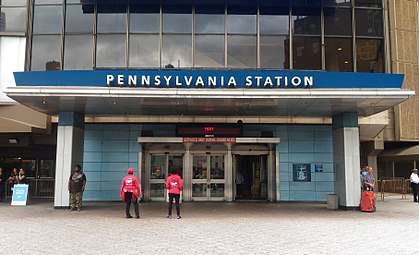 8th Avenue entrance
8th Avenue entrance.jpg) LIRR concourse
LIRR concourse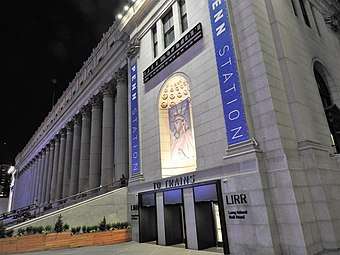 LIRR track entrance in Farley Post Office Building
LIRR track entrance in Farley Post Office Building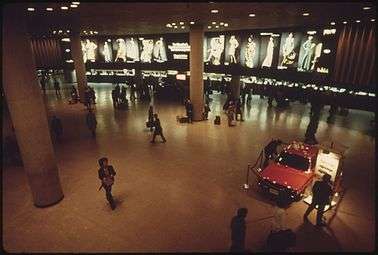 Amtrak concourse in 1974
Amtrak concourse in 1974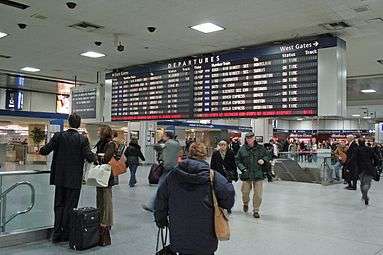 Amtrak departure board, removed in 2017
Amtrak departure board, removed in 2017- One of the last remnants of the original Penn Station, a staircase between tracks 3 and 4
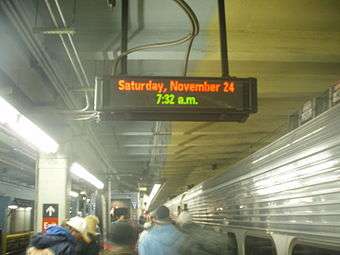 LIRR/Amtrak platform level
LIRR/Amtrak platform level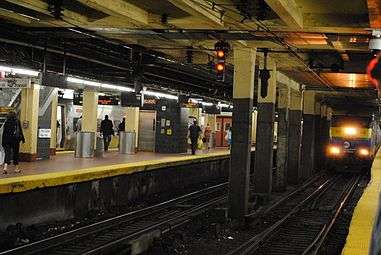 LIRR train arriving
LIRR train arriving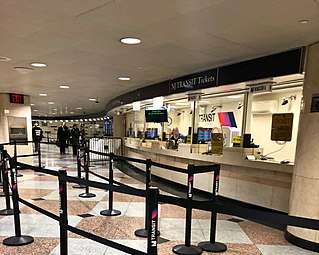 NJ Transit ticket counter
NJ Transit ticket counter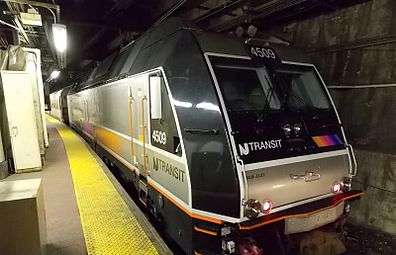 New Jersey Transit ALP-45DP locomotive at the platform
New Jersey Transit ALP-45DP locomotive at the platform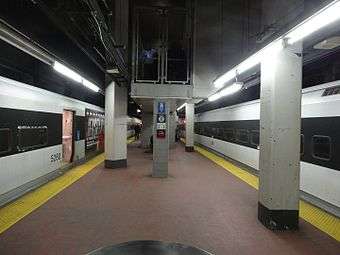 Two New Jersey Transit trains on tracks 3 and 4
Two New Jersey Transit trains on tracks 3 and 4
See also
- Pennsylvania Tunnel and Terminal Railroad
- Transportation in New York City
References
Notes
- The breakdown of Penn Station's ridership:
- Commuter and intercity rail comprise about 355,000 daily weekday passengers.
- LIRR has an average of 233,340 daily weekday passengers.
- NJ Transit has an average of 93,305 daily weekday passengers.
- Amtrak has an average of 28,487 daily passengers, when annual totals are averaged.
- The two subway stations have a combined average of approximately 200,000 daily weekday passengers. However, this only includes entries and not exits.
- The remainder of the ridership, around 75,000 passengers, may use other transportation such as buses, taxis, or ride-sharing, and may include passengers exiting from the subway.
- Commuter and intercity rail comprise about 355,000 daily weekday passengers.
Citations
- "NJ TRANSIT FACTS AT A GLANCE" (PDF). New Jersey Transit. Retrieved October 2, 2016.
- "How Many Riders Use NJ Transit's Hoboken Train Station?". Hoboken Patch. Retrieved July 18, 2018.
- "Amtrak Fact Sheet, FY2017, State of New York" (PDF). Amtrak. November 2017. Retrieved January 23, 2008.
- http://web.mta.info/mta/news/books/docs/2017%20LIRR%20Ridership%20Book.pdf
- Michael Kimmelman (April 24, 2019). "When the Old Penn Station Was Demolished, New York Lost Its Faith". The New York Times. Retrieved April 24, 2019.
- Devin Leonard (January 10, 2018). "The Most Awful Transit Center in America Could Get Unimaginably Worse". Bloomberg L.P. Retrieved November 14, 2018.
- "Remembering the Gimbels tunnel". New York Post. November 28, 2010. Retrieved December 14, 2018.
- Gray, Christopher (May 20, 2001). "Streetscapes/'The Destruction of Penn Station'; A 1960's Protest That Tried to Save a Piece of the Past". The New York Times. Retrieved September 6, 2018.
- Tangel, Andrew; West, Melanie Grayce (January 8, 2016). "New Name for Revamped Penn Station Surprises Moynihan Officials, Sparks Debate". WSJ. Retrieved March 6, 2019.
- Cudahy, Brian J. (2002), Rails Under the Mighty Hudson (2nd ed.), New York: Fordham University Press, p. 44, ISBN 978-0-82890-257-1, OCLC 911046235
- Roberts, Sam (January 18, 2013). "The Birth of Grand Central Terminal". The New York Times. Retrieved November 8, 2015.
- "New York – Penn Station, NY (NYP)". the Great American Stations. Amtrak. 2016.
- Donovan, Frank P. Jr. (1949). Railroads of America. Milwaukee: Kalmbach Publishing.
- Keys, C. M. (July 1910). "Cassatt and His Vision: Half a Billion Dollars Spent in Ten Years to Improve a Single Railroad – The End of a Forty-Year Effort to Cross the Hudson". The World's Work: A History of Our Time. XX: 13187–13204. Retrieved July 10, 2009.
- Klein, Aaron E (January 1988). History of the New York Central. Greenwich, Connecticut: Bison Books. p. 128. ISBN 0-517-46085-8.
- "PENNSYLVANIA'S TUNNEL UNDER NORTH RIVER; Property Already Acquired for the Great New York Terminal. TO PUSH THE CONSTRUCTION City Neighborhoods' to be Improved – Depth of the Tunnel So Great Subways Will Not Be Obstructed". The New York Times. December 12, 1901. ISSN 0362-4331. Retrieved May 22, 2018.
- McLowery, Randall (February 18, 2014). "The Rise and Fall of Penn Station – American Experience". PBS. Retrieved December 10, 2018.
- Mills, William Wirt (1908). Pennsylvania Railroad tunnels and terminals in New York City. Moses King. Retrieved May 26, 2018.
- Gilbert, Gilbert H.; Wightman, Lucius I.; Saunders, William L. (1912). "The East River Tunnels of the Pennsylvania Railroad". The Subways and Tunnels of New York: Methods and Costs, with an Appendix on Tunneling Machinery and Methods and Tables of Engineering Data. New York: John Wiley & Sons. p. 111. Retrieved October 11, 2009.
- "THE PENNSYLVANIA OPENS ITS SECOND RIVER TUBE; A Real Experience Tramping Through the Bores. HEADINGS MEET EXACTLY Brief Ceremonies as the Engineers Pass the Shield of the New North River Section. THE PENNSYLVANIA OPENS ITS SECOND RIVER TUBE". The New York Times. October 10, 1906. Retrieved May 23, 2018.
- "FOURTH RIVER TUBE THROUGH; Last of Pennsylvania-Long Island Tunnels Connected – Sandhogs Celebrate". The New York Times. March 19, 1908. Retrieved May 23, 2018.
- "DAY LONG THRONG INSPECTS NEW TUBE; 35,000 Persons Were Carried on the First Day of Pennsylvania's Tunnel Service. ACCIDENT MARRED OPENING Morning Trains Delayed Two Hours by Broken Third Rail – Some Complaints Over Extra Fare". The New York Times. September 9, 1910. Retrieved May 22, 2018.
- "PENNSYLVANIA OPENS ITS GREAT STATION; First Regular Train Sent Through the Hudson River Tunnel at Midnight". The New York Times. November 27, 1910. ISSN 0362-4331. Retrieved May 23, 2018.
- "Pennsylvania Railroad Company – American railway". Encyclopedia Britannica. March 1, 1976. Retrieved May 19, 2019.
- Michael Kimmelman (April 24, 2019). "When the Old Penn Station Was Demolished, New York Lost Its Faith". The New York Times.
- Grynbaum, Michael M. (October 18, 2010). "The Joys and Woes of Penn Station at 100". The New York Times. Retrieved February 3, 2013.
- The Railway and Engineering Review article says at their highest the station tracks were nine feet below sea level.
- Gray, Christopher (May 20, 2001). "'The Destruction of Penn Station'; A 1960's Protest That Tried to Save a Piece of the Past". The New York Times. Retrieved January 16, 2010.
- Tolchin, Martin (October 29, 1963). "Demolition Starts At Penn Station; Architects Picket; Penn Station Demolition Begun; 6 Architects Call Act a 'Shame'". The New York Times. Retrieved May 22, 2018.
- "New York – Penn Station, NY (NYP)", Great American Stations Project. 2013 Amtrak. Retrieved October 5, 2013
- Rasmussen, Frederick N. (April 21, 2007). "From the Gilded Age, a monument to transit". The Baltimore Sun.
- "Farewell to Penn Station". The New York Times. October 30, 1963. Retrieved July 13, 2010.
- Herbert Muschamp, "Architecture View; In This Dream Station Future and Past Collide," New York Times, June 20, 1993.
- Blair Kamin (January 23, 2005). "New Randolph station works within its limits". The Chicago Tribune.
- Jon Weinstein (January 29, 2013). "Grand Central Terminal At 100: Legal Battle Nearly Led To Station's Demolition". NY1. Archived from the original on June 17, 2013.
- Doherty, Matthew (November 7, 2004). "Far West Side Story". The New York Times. Retrieved March 6, 2010.
- "Travel Advisory; Grand Central Trains Rerouted To Penn Station". The New York Times. April 7, 1991. Retrieved February 7, 2010.
- Johnson, Kirk (July 7, 1988). "Amtrak Trains To Stop Using Grand Central". The New York Times. Retrieved November 10, 2015.
- Barron, James (April 8, 1991). "Riding the Past From Grand Central". The New York Times. Retrieved December 11, 2018.
- Lueck, Thomas J. (June 17, 2003). "THREATS AND RESPONSES: SECURITY; Schumer Praises Work for Safer Penn Station, but Wants More". The New York Times. Retrieved December 14, 2018.
- "A Station Worthy of New York". The New York Times. November 2, 2007. Retrieved November 26, 2007.
- Leonard, Devin (January 10, 2018). "The Most Awful Transit Center in America Could Get Unimaginably Worse". Bloomberg Business Week. Retrieved January 10, 2018.
- Randolph, Eleanor (March 28, 2013). "Transplanting Madison Square Garden". Taking Note. Retrieved January 8, 2016.
- Robert Sciarrino (December 26, 2013). "How to squeeze 1,200 trains a day into America's busiest transit hub". The Star-Ledger. Retrieved January 8, 2016.
...a transit hub that handles 650,000 people a day — twice as busy as America’s most-used airport in Atlanta and busier than Newark, LaGuardia and JFK airports combined.
- Jackson, Kenneth T., ed. (1995). The Encyclopedia of New York City. New Haven: Yale University Press. ISBN 0300055366.
- Empire State Development. "About Moynihan Station.". Retrieved March 7, 2011.
- "Subway Map" (PDF). Metropolitan Transportation Authority. October 21, 2019. Retrieved January 18, 2018.
- "Manhattan Bus Map" (PDF). Metropolitan Transportation Authority. December 2017. Retrieved April 24, 2018.
- "Our Bus Stops — Vamoose Bus". Retrieved January 9, 2015.
Dropoff Locations: Penn Station, 7th Ave. Corner of W 30th Street
- "Our Pick-Up and Drop-Off Locations — Tripper Bus". Retrieved January 30, 2019.
Pick-Up Drop-Off Locations: Penn Station, NE corner of 31 St between 7th and 8th Ave
- "U.S. and Canada Reservations Contact Information". United Airlines. Retrieved June 11, 2012.
- "U.S. & Canada Reservations Contact Information". Continental Airlines. Archived from the original on April 12, 2010. Retrieved June 11, 2011.
- "Penn Station Access Study". Mta.info. Retrieved April 23, 2015.
- "Station Directory – Penn Station, NY" (PDF). NJ Transit. Retrieved May 26, 2018.
- "Commissioner Fox Unveils New 7th Avenue Concourse at Penn Station N.Y." (Press release). NJ Transit. September 18, 2002. Retrieved January 16, 2010.
- Lautenberg, Saundra and Baumann, Lynne M. (2000). "New Jersey Transit's East End Concourse."
- Fahim, Kareem (November 6, 2006). "New Penn Station Entrance Is Planned by N.J. Transit". The New York Times. Retrieved July 18, 2009.
- Schaer, Sidney C. (October 23, 1994). "As LIRR Renovation Ends, Who's Laughing Now?". Newsday.
- Washington, Ruby (December 12, 1986). "New Concourse Opens at Pennsylvania Station". The New York Times. Retrieved July 18, 2009.
- McGeehan, Patrick (December 13, 2017). "Lost in Penn Station? Amtrak Has an App to Guide You". The New York Times. ISSN 0362-4331. Retrieved December 17, 2017.
- "Penn Station", station layout, mta.info
- "Penn Station Track System". Amtrak. May 2017. Archived from the original on July 15, 2017. Retrieved May 26, 2018.
- Nowakowski, Patrick (April 24, 2017). Metro-North/LIRR Committee Meeting (Board meeting). Event occurs at 15:45. Retrieved April 29, 2017.
- "Long Island Rail Road Timetable No. 4" (PDF). May 14, 2012. p. I-81. Retrieved April 29, 2017.
- "Amtrak Northeast Corridor Employee Timetable No. 6" (PDF). National Transportation Safety Board Docket Management System. February 22, 2016. p. 72. Retrieved April 29, 2017.
- "Long Island Rail Road Timetable No. 4" (PDF). May 14, 2012. p. I-59. Retrieved April 29, 2017.
- "Amtrak Northeast Corridor Employee Timetable No. 6" (PDF). National Transportation Safety Board Docket Management System. February 22, 2016. p. 209. Retrieved April 29, 2017.
- LaForgia, Michael (October 9, 2017). "Before Derailments at Penn Station, Competing Priorities Led to Disrepair". The New York Times. ISSN 0362-4331. Retrieved October 9, 2017.
- Fitzsimmons, Emma G.; Corasaniti, Nick (April 6, 2017). "Amtrak Knew of Flaw That Caused Penn Station Derailment". The New York Times. ISSN 0362-4331. Retrieved April 28, 2017.
- Fitzsimmons, Emma G.; Mcgeehan, Patrick (April 25, 2017). "Amtrak Said to Weigh Extended Track Closings for Penn Station Repairs". The New York Times. ISSN 0362-4331. Retrieved April 28, 2017.
- Rubinstein, Dana (May 5, 2014). "Clock ticking on Hudson crossings, Amtrak warns". Capital. Archived from the original on May 10, 2014. Retrieved May 20, 2014.
- "Rail officials say derailment disruptions could last days". AP News. Retrieved April 28, 2017.
- "Penn Station stampede: 16 injured in chaos amid false reports of gun shots". Fox News. April 15, 2017. Retrieved April 29, 2017.
- "Schumer: Boost communication after Penn Station stampede". New York's PIX11 / WPIX-TV. April 23, 2017. Retrieved April 28, 2017.
- Fitzsimmons, Emma G.; Mcgeehan, Patrick (April 27, 2017). "Amtrak Plans to Close Several Penn Station Tracks for Major Repairs". The New York Times. ISSN 0362-4331. Retrieved April 29, 2017.
- "LIRR mulls suing Amtrak over Penn Station derailments". News 12 Long Island. Archived from the original on April 29, 2017. Retrieved April 28, 2017.
- Mcgeehan, Patrick (May 2, 2017). "Amtrak's Plan for Penn Station Repairs Calls for 44 Days of Closed Tracks". The New York Times. ISSN 0362-4331. Retrieved May 2, 2017.
- Mcgeehan, Patrick (September 1, 2017). "Summer Was Not So Hellish for Commuters at Penn Station". The New York Times. ISSN 0362-4331. Retrieved September 5, 2017.
- Saul, Emily (July 9, 2017). "'Summer of Hell' at Penn Station kicks off this week". New York Post. Retrieved September 5, 2017.
- Mcgeehan, Patrick (August 3, 2017). "This Summer, PATH Is on the Big Stage". The New York Times. ISSN 0362-4331. Retrieved September 11, 2017.
- "6 Amtrak trains to use Grand Central Terminal this summer". lohud.com. June 12, 2017. Retrieved April 17, 2018.
- Wolfe, Jonathan (September 5, 2017). "New York Today: 'Summer of Hell' Comes to an End". The New York Times. ISSN 0362-4331. Retrieved September 5, 2017.
- "Full service resumes at Penn Station after 8 weeks of repair work". ABC7 New York. September 5, 2017. Archived from the original on September 5, 2017. Retrieved September 5, 2017.
- "Amtrak Announces Summer Infrastructure Renewal Work – Amtrak Media". Amtrak Media. April 10, 2018. Retrieved June 9, 2018.
- "New York-Chicago Direct Train Shuts Down for First Time in Over a Century". The New York Times. June 8, 2018. ISSN 0362-4331. Retrieved June 9, 2018.
- "How to always get a seat at NYC Penn Station on Amtrak and NJ Transit".
- Amtrak ClubAcela access eligibility and rules. Retrieved 11 April 22:45 GMT
- "Amtrak — Stations — New York, NY — Penn Station (NYP)".
- "Gateway Project" (PDF). Amtrak. February 2011. Archived from the original (PDF) on May 17, 2013. Retrieved February 7, 2011.
- McGeehan, Patrick (February 7, 2011). "With One Plan for a Hudson Tunnel Dead, Senators Offer Another Option". The New York Times. Retrieved February 9, 2011.
- "West Side Construction Project May Bring New Rail Tunnel Pathways To …". NY1.com. November 6, 2013. Archived from the original on November 6, 2013. Retrieved October 26, 2017.
- Rouse, Karen (December 6, 2012). "Amtrak asks Congress for emergency funding for flood protection". The Record. Archived from the original on December 13, 2013. Retrieved November 12, 2012.
- Goldmark, Alex (December 13, 2012). "Amtrak asks for subsidies in wake of Hurricane Sandy". Transportation Nation. Retrieved December 15, 2012.
- "Take a ride inside the aging Hudson River train tunnels that would cost billions to replace (VIDEO)". The Star-Ledger.
- Bazeley, Alex (July 6, 2017). "The Hudson Tunnel Project is expected to cost $12.9 billion". am New York. Retrieved May 7, 2018.
- News, ABC (July 6, 2017). "Price for New York-New Jersey rail tunnel rises to $12.9B". ABC News. Archived from the original on July 7, 2017. Retrieved July 9, 2017.
- "New York-New Jersey Rail Project Gets Some Money in Congress Deal". Bloomberg.com. March 21, 2018. Retrieved March 28, 2018.
- Guse, Clayton (March 27, 2018). "A pair of crucial new Hudson River tunnels just took a major step forward". Time Out New York. Retrieved March 28, 2018.
- Hana R. Alberts (May 29, 2013). "Four Plans For A New Penn Station Without MSG, Revealed!". Curbed. Retrieved October 26, 2014.
- Rubinstein, Dana (October 10, 2018). "Urbanists again aim to remake Penn Station and insist this time it will be different". Politico PRO. Retrieved January 19, 2019.
- Randolph, Eleanor (June 2013). "Bit by Bit, Evicting Madison Square Garden". The New York Times. Retrieved July 8, 2013.
- Bagli, Charles (July 24, 2013). "Madison Square Garden Is Told to Move". The New York Times. Retrieved July 25, 2013.
- Hana R. Alberts (October 23, 2014). "Moving the Garden Would Pave the Way for a New Penn Station". Curbed. Retrieved October 26, 2014.
- "MSG & the Future of West Midtown". Retrieved April 14, 2015.
- Higgs, Larry (January 6, 2016). "Gov. Cuomo unveils grand plan to rebuild N.Y. Penn Station". The Star-Ledger. Retrieved January 6, 2016.
- "6th Proposal of Governor Cuomo's 2016 Agenda: Transform Penn Station and Farley Post Office Building Into a World-Class Transportation Hub". Governor Andrew M. Cuomo. Retrieved January 7, 2016.
- Friends of Moynihan Station Archived March 4, 2016, at the Wayback Machine. Moynihanstation.org (July 1, 2006). Retrieved July 26, 2013.
- Laura Kusisto; Eliot Brown (March 2, 2014). "New York State Pushes for Penn Station Plan". The Wall Street Journal.
- S.1077 – A bill to dedicate the new Amtrak station in New York, New York, to Senator Daniel Patrick Moynihan. Congress.gov (May 19, 1999). Retrieved April 27, 2016.
- Bagli, Charles V. (March 6, 2015). "New Grandeur for Penn Station in Latest Plan". The New York Times. Retrieved March 6, 2019.
- Moynihan Station Redevelopment 2001 Design | SOM | Skidmore, Owings & Merrill LLP Archived October 20, 2013, at the Wayback Machine. SOM. Retrieved July 26, 2013.
- Dunlap, David W. (October 26, 2006). "With Each Redesign, a Sparer Penn Station Emerges". The New York Times.
- Moynihan Station Redevelopment 2007 Design | SOM | Skidmore, Owings & Merrill LLP Archived October 20, 2013, at the Wayback Machine. SOM (March 19, 2010). Retrieved July 26, 2013.
- Inside the Retro-Futuristic Moynihan Station: Newest Plans Are a Throwback to the Old Post Office. Observer (July 10, 2012). Retrieved July 26, 2013.
- "Moynihan Station Development Corporation and NJ Transit Agree to Partner in Moynihan Station" (Press release). Empire State Development Corporation. November 21, 2005. Archived from the original on December 26, 2009. Retrieved January 16, 2010.
- Magnet, Alec (November 22, 2005). "New Jersey Transit To Be Anchor Rail Tenant of Proposed Station". New York Sun. Retrieved January 16, 2010.
- Corley, Colleen (February 15, 2006). "Online High Expectations for Madison Square Garden's Rumored $750M Move". Commercial Property News. Retrieved January 16, 2010.
- Bagli, Charles V. (April 4, 2009). "Garden Unfurls Its Plan for a Major Renovation". The New York Times. Retrieved January 16, 2010.
- Friends of Moynihan Station Archived March 4, 2016, at the Wayback Machine. Moynihanstation.org (August 30, 2005). Retrieved July 26, 2013.
- Michaelson, Juliette (February 16, 2010). "Moynihan Station Awarded Federal Grant" (PDF). Friends of Moynihan Station. Archived from the original (PDF) on July 14, 2010. Retrieved February 17, 2010.
- "New York Penn Station expansion to finally see light of day". Trains. October 18, 2010. Retrieved October 20, 2010.
- "Work to begin on massive Penn Station expansion". Long Island Business News. Associated Press. May 9, 2012. Retrieved May 9, 2012.
- "3 contractors picked for Penn Station overhaul". Associated Press. September 27, 2016. Retrieved September 28, 2016.
- Warerkar, Tanay (June 15, 2017). "Penn Station's West End Concourse finally opens to the public". Curbed NY. Retrieved June 23, 2017.
- Friends of Moynihan Station Archived March 4, 2016, at the Wayback Machine. Moynihanstation.org (August 24, 2005). Retrieved July 26, 2013.
- Bagli, Charles V. (September 27, 2016). "Cuomo's Vision for Revamped Penn Station: New Home for Amtrak and L.I.R.R." The New York Times. ISSN 0362-4331. Retrieved September 28, 2016.
- Hardt, Bob (January 7, 2016). "NY1 ItCH: Let's Not Rename Moynihan Station". Spectrum News NY1 | New York City. Retrieved March 6, 2019.
- Nasa, Rahima; Blain, Glenn (August 17, 2017). "Cuomo touts $1.6B train hall project next to Penn Station". NY Daily News. Retrieved September 6, 2017.
- Guse, Clayton (June 20, 2017). "Penn Station is officially getting a massive expansion". Time Out New York. Retrieved May 27, 2018.
- "Midtown block could permanently close for Penn project". am New York. September 6, 2018. Retrieved September 7, 2018.
- "news – Governor Cuomo Announces New Main Entrance to Penn Station and Expansion of LIRR Concourse". MTA. September 6, 2018. Retrieved September 7, 2018.
- "More space, accessibility part of $600 million Penn Station makeover". am New York. March 15, 2019. Retrieved March 18, 2019.
- Siff, Andrew (January 6, 2020). "Cuomo: 8 New Tracks to Be Added to NY Penn Station". NBC New York. Retrieved January 7, 2020.
- Higgs, Larry (January 6, 2020). "Penn Station expansion will make getting to NYC easier, Cuomo says". nj. Retrieved January 7, 2020.
- Vielkind, Jimmy. "Cuomo Says State Will Acquire Manhattan Block to Expand Penn Station". WSJ. Retrieved January 7, 2020.
- "Empire Station complex plan includes big rail expansion for Penn Station: Cuomo". amNewYork. January 6, 2020. Retrieved January 26, 2020.
Bibliography
- Diehl, Lorraine B. (1985). The Late, Great Pennsylvania Station. Lexington, MA: Stephen Greene Press. ISBN 0-8289-0603-3.
- Johnston, Bob (January 2010). "Penn Station: How do they do it?". Trains. 70 (1): 22–29. Includes track diagram.
External links
| Wikimedia Commons has media related to |
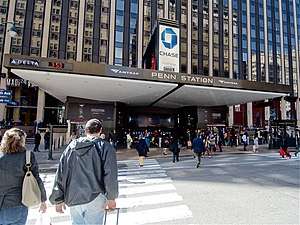
%26groups%3D_2904c7632e1b7f51ff221a3b61f6d3353cc3d1b9.svg)